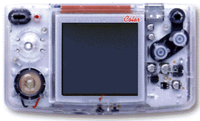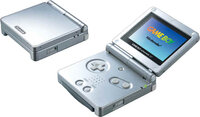Sixth generation era
|
|
Template:CVG history The sixth-generation era (sometimes referred to as the handheld era, nostalgia era, or 128-bit era) refers to the current crop of computer and video games, video game consoles, and video game handhelds. Prominent platforms of the sixth generation are the Nintendo GameCube, Sony PlayStation 2, and Microsoft Xbox.
| Contents |
"The handheld era"
During the sixth generation era, the handheld market had a sudden explosion with the introduction of a number of new handheld devices from many different manufacturers. Nonetheless, Nintendo maintained their large market share of the handheld market with the release in 2001 of the highly upgraded Game Boy called the Game Boy Advance. Two redesigns of this system followed. The first, the Game Boy Advance SP in 2003 and the second, the Game Boy Micro in 2005. Also introduced was the Neo Geo Pocket Color in 1998 and Bandai's WonderSwan Color launched in Japan in 1999.
A major new addition to the market was the introduction of features not exclusive to the video game industry. Everything from cell phones, MP3 players, portable movie players, to Palm Pilot-like features. The first of these was Nokia's N-Gage, which was released in 2003 and doubled primarily as a mobile phone. It subsequently went through a redesign in 2004 and was renamed the N-Gage QD. A second handheld, the Zodiac from Tapwave was released in 2004 and was based on the PalmOS; it added numerous features typically found in PDAs.
With more and more handhelds arriving towards the end of this generation, it is hard to locate exactly where the sixth generation ends and where the new seventh generation begins. It is believed that the seventh generation began in late 2004 with the introduction of Nintendo's Nintendo DS and Sony's PlayStation Portable.
"The darkest era"
Main article: Video game controversy
The sixth generation era is believed by some to be the darkest era in the history of video games. It features criticisms of "objectionable" content such as sex, crime, and violence as well as topics of debate such as religion, politics, feminism, and economics.
The sixth generation also began just prior to the September 11, 2001 attacks in New York City, which had a huge impact on the entertainment industry as well as the video game industry forcing many games to be toned down. Most notably Metal Gear Solid 2, which prior to to release depicted the destruction of the Statue of Liberty and a good portion of Manhattan.
"The nostalgia era"
Main article: Console emulator
The sixth generation is also dubbed the nostalgia era due to the increase usage of emulators and the increasing ease of finding ROM images of previous video game consoles. Most notably the Nintendo Entertainment System, the Super Nintendo Entertainment System, the Sega Master System and the Sega Genesis.
It is also a time when an increasing number of retro games are being enhanced or redistributed on newer systems. Enhanced remakes occur mostly on consoles, while redistributions occur mostly on handhelds. The enhanced remake idea was actually devised during the 16-bit era with Nintendo's Super Mario All-Stars, however, it was popularized during this era. Examples of the redistribution idea include Nintendo's introduction of a line of "classic" NES and SNES games for their Game Boy Advance handheld. Examples of the enhancement idea include Wild ARMs: Alter Code F, Square Enix's Final Fantasy Origins, and Nintendo's Metroid: Zero Mission. Also an increasing number of third-party developers releasing anthology collection games such as Midway Games, Capcom, and Namco. Additionally, this is also a time when certain video games or video game series that were originally confined to Japan came to North America and Europe.
"128-bit era"
Bit ratings for consoles largely fell by the wayside after the 32-bit era. The number of "bits" cited in console names referred to the CPU word size, but there was little to be gained from increasing the word size much beyond 32-bits; performance depended on other factors, such as processor speed, graphics processor speed, bandwidth and memory size.
The Sega Dreamcast, known as the first of the "128-bit" consoles, has a 64-bit CPU, GPU, and data bus although the geometry sub-processor GPU can perform internal math on 128-bit words. One of the PlayStation 2's many processors is known as the "128-bit Emotion Engine" but has a 64-bit core; the graphics synthesizer has a 2560-bit DRAM bus. Finally, the Microsoft Xbox uses a 32-bit CPU and 256-bit GPU, a configuration that is becoming standard in many desktop computers. The important of "bitness" in the modern console gaming market has thus decreased due to the use of components that process data in varying word sizes; for this reason, the sixth generation era is not commonly referred to as the "128-bit era".
Video game systems
Video game consoles
Video game consoles released during the sixth generation era include:
Note: First year of release is the first year of the system's availability in the world.
Video game handhelds
Video game handhelds released during the sixth generation era include:
Note: First year of release is the first year of the system's availability in the world.




